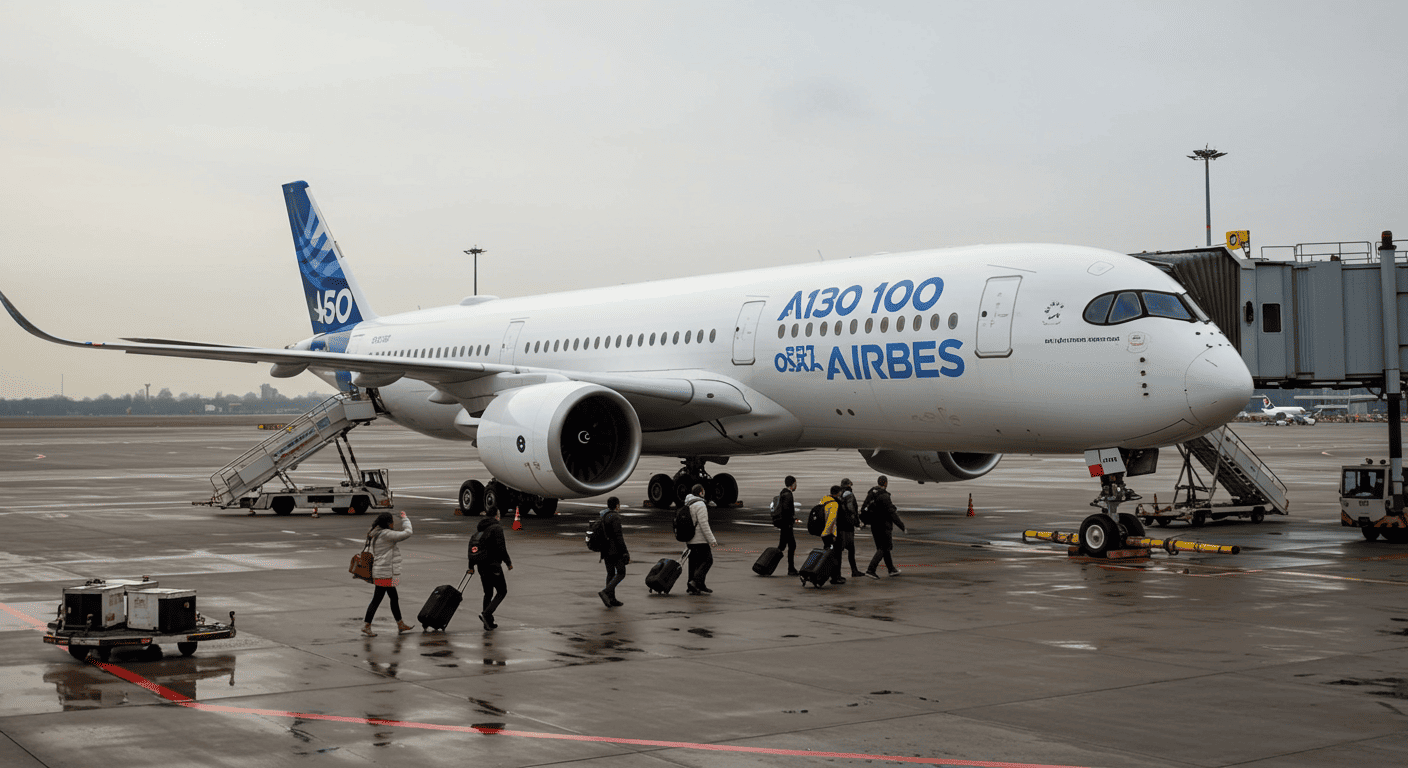The Airbus A350-1000 is the largest member of the A350 family, designed for high-density, long-haul routes with exceptional efficiency. By combining advanced aerodynamics and lightweight materials, it offers airlines lower operating costs and passengers a quieter, more spacious cabin. Here’s a look at its key specifications and features.
Overview of the Airbus A350—1000
The Airbus A350-1000 is the largest member of the advanced A350 family—a twin-engine, wide-body jetliner that redefines long-haul travel. Building on the success of its smaller sibling, the A350-900, this longer variant offers significantly more capacity and efficiency on high-density routes. It’s a masterful combination of state-of-the-art aerodynamics, cutting-edge design, and advanced technologies, combining to deliver superior performance and passenger comfort.
Stretching nearly 74 meters, the A350-1000’s fuselage accommodates significantly more passengers than the A350-900, positioning it as a direct competitor to other large jets. This increased capacity provides airlines with a highly versatile aircraft for connecting the world’s major international hubs.
Environmental sustainability is central to its design, achieved through a lightweight airframe built with over 50% carbon composites and advanced alloys. When paired with its highly efficient Rolls-Royce Trent XWB-97 engines, this approach dramatically reduces fuel burn, CO2 emissions, and noise levels compared to previous-generation aircraft.
Specifications of the Airbus A350—1000
Dimensions and Capacity
- Length: 73.79 meters
- Wingspan: 64.75 meters
- Height: 17.08 meters
- Typical Seating: 350–410 passengers (three-class)
- Maximum Seating: 480 passengers (single-class)
Performance Metrics
The aircraft’s range is particularly impressive, capable of flying non-stop for up to 16,100 kilometers (8,700 nautical miles) while maintaining an efficient cruising speed of Mach 0.85. This extensive reach, supported by a Maximum Takeoff Weight (TOW) of 319 tonnes, enables it to connect distant hubs with a full complement of passengers and cargo on the world’s most demanding routes.
Its combination of advanced aerodynamics, a lightweight composite airframe, and efficient Trent XWB-97 engines delivers a remarkable 25% reduction in fuel burn and CO2 emissions compared to previous-generation aircraft.
Cabin Features and Comfort
The design of the Airbus A350-1000’s Airspace cabin is designed around the passenger experience. Its extra-wide fuselage creates a tangible sense of space, allowing for wider seats and more personal room, even in economy class.
High ceilings and near-vertical sidewalls enhance the feeling of openness by maximizing shoulder and headspace.
The A350-1000 also incorporates technology to improve passenger well-being:
- Advanced Air Filtration: The cabin air is fully renewed every two to three minutes, maintaining optimal humidity and quality to reduce travel fatigue.
- LED Mood Lighting: A sophisticated system with millions of color options simulates natural light transitions to help minimize jet lag.
The aircraft’s flexible cabin platform allows airlines to design distinctive premium experiences. Depending on the operator, passengers might find luxurious private suites with closing doors, social lounges, or even exclusive amenities like showers. This versatility allows airlines to tailor the A350-1000 for their flagship routes, offering a new level of comfort in the skies.
Cabin Layout and Sections
The cabin is typically arranged in a three-class configuration:
- Business Class: Located at the front, this section often features lie-flat seats with direct aisle access. Many airlines install luxurious private suites with closing doors for maximum privacy.
- Premium Economy: This section serves as a middle ground, offering wider seats, more legroom, and enhanced meal services compared to Economy.
- Economy: The main cabin typically features a spacious 9-abreast seating configuration with wider seats (around 18 inches), providing more personal space than the 10-abreast layouts on some competing aircraft.
Airline Operators of the A350—1000
The A350-1000 is a flagship aircraft for many prestigious international airlines, valued for its combination of range, capacity, and efficiency on high-demand routes. Key operators deploying it on premier intercontinental services include:
- Qatar Airways (launch customer)
- Cathay Pacific
- British Airways
- Delta Air Lines
Airlines favor this aircraft for its significant operational advantages. An extended range of up to 16,100 km, combined with a capacity for 350 to 410 passengers, allows operators to serve distant destinations profitably. The aircraft’s advanced technology, from its fuel-efficient engines to its lightweight composite airframe, translates directly into lower operating costs and a reduced environmental footprint—both critical factors in modern aviation.
The A350-1000’s appeal also lies in the superior passenger experience it enables. The quiet, spacious cabin provides an ideal setting for airlines to showcase their premium products, helping them enhance their brand reputation and attract discerning travelers on competitive long-haul flights.
Delta Air Lines and the A350—1000
Delta Air Lines is deploying the Airbus A350-1000 to modernize its long-haul international fleet. The airline’s configuration provides a high standard of comfort on its most competitive routes, reflecting a commitment to a modern, efficient, and passenger-friendly fleet.
Onboard Delta’s A350-1000, passengers will find a suite of premium amenities designed for connectivity and comfort:
- Delta One Suites: Private suites with fully flat beds.
- Connectivity: Fast, free in-flight Wi-Fi and in-seat power outlets.
- Entertainment: The Delta Studio system with over 1,000 hours of content.
Comparative Analysis: A350—1000 vs A350—900
As the larger sibling in the A350 XWB family, the A350-1000 is essentially a stretched version of the highly successful A350-900. Its primary distinction is length: at 73.79 meters, it is roughly 7 meters longer, which allows it to seat 350–410 passengers compared to the 300–350 capacity of the A350-900.
Supporting its increased size and weight required several key design modifications. The A350-1000 features a slightly larger wing to enhance aerodynamic performance and relies exclusively on two more powerful Rolls-Royce Trent XWB-97 engines. These upgrades allow the aircraft to manage a higher maximum takeoff weight of 319 tonnes without compromising its exceptional performance.
Despite these differences, both models share the A350 family’s core advantages, including up to 25% better fuel efficiency over previous-generation aircraft, lower emissions, and a superior passenger experience.
Conclusion and Future of the A350—1000
The Airbus A350-1000 represents a significant achievement in modern aerospace engineering, combining high capacity, extended range, and exceptional efficiency. More than just a stretched version of its predecessor, it is a strategic tool for airlines competing on high-demand, long-haul routes. By delivering a superior passenger experience with strong economics, the A350-1000 has secured its position as a leader in the wide-body market.
Looking ahead, the Airbus A350-1000 is well-suited to meet the industry’s future demands. As airlines retire older, less efficient four-engine aircraft, the A350-1000 offers a powerful and profitable replacement. Its combination of advanced technology, passenger-focused comfort, and strong environmental performance ensures it will remain a key part of global airline fleets for decades to come.
Read more:
- Airbus A320: Specifications, Features, and Seat Maps
- Airbus A340-300: Features, Specifications, and Performance
- Airbus A220: Features, Specs, and Benefits of the A220 Family
- Airbus Beluga: The Unique Transport Aircraft
- Airbus A340-600: Features, Specifications, and Performance
- Airbus A350: Features, Specs, and Innovations
- Airbus A319: Specifications, Seat Maps, and Features
- Airbus A321neo: Features, Specs, and Benefits
- Airbus A321: Specifications, Features, and Seat Maps
- Airbus A380: The Ultimate Guide to the World’s Largest Passenger Aircraft
- Airbus A330-300: Specifications, Seat Maps, and Amenities
- Airbus A350-900: Features, Specs, and Seating Guide
- Airbus A330: Specifications, Features, and Seat Maps

